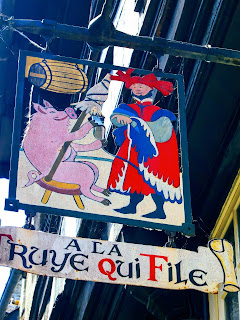 |
| PARIS FRANCE |
The old Medieval towns of Europe come with intriguing
stone walls, moats, cobblestone streets, clock towers, gates,
churches, and castles. They are also adorned with hanging signs that
stick out perpendicular above the business doors that can easily be
seen from afar. The signs vary in shape and color, however, they
always come with a symbol or picture depicting the product or craft
made in the shop. Best of all they can be found throughout the
countries of Europe.
The Middle Ages lasted in Europe from around 600 to 1500
AD. It was during these times that individuals joined together to
form guilds or working groups that represented all of the trades and
crafts performed within a town. There were tanners, bakers,
shoemakers, apothecaries, candle makers, and more, each displaying
its unique signage to attract customers.
Up until the 1500s few people could read or write,
consequently, there was little writing on the signs. A butcher shop
might use a picture of a cow or pig, a pharmacist often displayed a
mortar and pestle, and a blacksmith might use a crossed hammer and
sickle to portray his business. Quite often, the signs were
silhouettes made of black wrought iron—these are particularly
impressive on a blue sky day with mountains in the backdrop.
Through the years most of the Medieval towns have been
destroyed due to war, disasters, and neglect, however, there are
still, many that have stood the test of time. Here is a list, prepared
by WorldAtlas.com, of 15 amazingly well-preserved Medieval towns in Europe:
Nordlingen, Germany Toledo, Spain
Carcassonne, France Bruges, Belgium
Torun, Poland Siena, Italy
Dubrovnik, Croatia Ptuj, Slovenia
Ohrid, Macedonia Chester, England
Prague, Czechia Bergen, Norway
Obidos, Portugal Delft,
Netherlands
Tallinn, Estonia









I always relax and enjoy all of your interesting places, people and history.
ReplyDeleteEspecially now, your experiences carry me away.
Thank you for the note and I'm glad you enjoy my blog. Let's hope that things get back to normal soon.
DeleteI appreciate this article because it reminds me that it's easy to forget, that the signs would be painted (to be more visible and to protect them from the elements).
ReplyDeleteJust like Roman statues were not the bare stone as we know them, during their empire they were painted and quite garishly.
wonderful little snipped of information, loved the photo examples
ReplyDelete